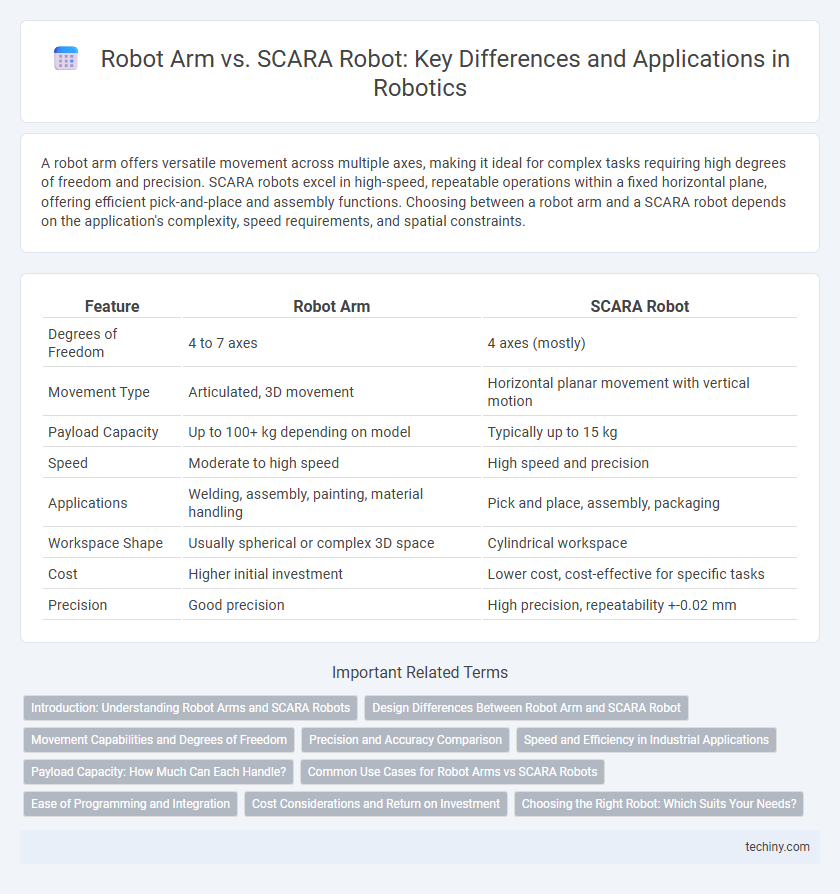A robot arm offers versatile movement across multiple axes, making it ideal for complex tasks requiring high degrees of freedom and precision. SCARA robots excel in high-speed, repeatable operations within a fixed horizontal plane, offering efficient pick-and-place and assembly functions. Choosing between a robot arm and a SCARA robot depends on the application's complexity, speed requirements, and spatial constraints.
Table of Comparison
| Feature | Robot Arm | SCARA Robot |
|---|---|---|
| Degrees of Freedom | 4 to 7 axes | 4 axes (mostly) |
| Movement Type | Articulated, 3D movement | Horizontal planar movement with vertical motion |
| Payload Capacity | Up to 100+ kg depending on model | Typically up to 15 kg |
| Speed | Moderate to high speed | High speed and precision |
| Applications | Welding, assembly, painting, material handling | Pick and place, assembly, packaging |
| Workspace Shape | Usually spherical or complex 3D space | Cylindrical workspace |
| Cost | Higher initial investment | Lower cost, cost-effective for specific tasks |
| Precision | Good precision | High precision, repeatability +-0.02 mm |
Introduction: Understanding Robot Arms and SCARA Robots
Robot arms serve as versatile manipulators with articulated joints, enabling multi-axis movement ideal for complex assembly tasks and material handling. SCARA robots, designed with selective compliance in the horizontal plane, excel in high-speed, precision applications like pick-and-place operations and electronics assembly. Understanding the mechanical design and operational strengths of each type is essential for selecting the appropriate robotic solution in manufacturing automation.
Design Differences Between Robot Arm and SCARA Robot
Robot arms typically feature articulated joints with multiple degrees of freedom, enabling complex, multi-directional movements necessary for tasks requiring high flexibility and precision. In contrast, SCARA robots have a rigid, cylindrical structure with two parallel rotary joints and a vertical sliding joint, optimized for horizontal movements and fast, repeatable assembly operations. The distinct design differences influence their applications, with robot arms excelling in versatile environments and SCARA robots optimizing speed and accuracy in planar tasks.
Movement Capabilities and Degrees of Freedom
Robot arms typically feature multiple degrees of freedom, often ranging from 4 to 7 joints, allowing for versatile movement in 3D space including rotation, extension, and wrist articulation. SCARA robots usually have 4 degrees of freedom optimized for high-speed, precise, planar movement with vertical motion, making them ideal for pick-and-place tasks. The choice between a multi-axis robot arm and a SCARA robot depends on the complexity of movement required and the spatial constraints of the application.
Precision and Accuracy Comparison
Robot arms generally offer higher degrees of freedom, resulting in versatile motion but varying precision depending on joint calibration and control systems. SCARA robots excel in horizontal plane tasks with superior repeatability and accuracy due to their rigid structure and simplified kinematics, typically achieving positional accuracy within +-0.02 mm. The choice between a robot arm and a SCARA robot depends on application requirements, where high precision in assembly or pick-and-place tasks favors SCARA designs.
Speed and Efficiency in Industrial Applications
Robot arms and SCARA robots both enhance industrial automation, with SCARA robots excelling in speed due to their specialized design for horizontal movements and rapid pick-and-place tasks. Robot arms offer greater flexibility across multiple axes but typically operate at slower speeds when compared to SCARA robots, impacting cycle time in high-volume production. Industrial applications requiring quick, repetitive motions often favor SCARA robots for superior efficiency, while robot arms are preferred for complex, multi-directional tasks.
Payload Capacity: How Much Can Each Handle?
Robot arms generally offer a higher payload capacity, often handling loads ranging from a few kilograms up to several hundred kilograms, depending on the model and application. SCARA robots typically manage lighter payloads, usually between 1 to 10 kilograms, optimized for precise assembly tasks requiring speed and accuracy. Payload capacity is a critical factor in selecting between a robot arm for heavy-duty industrial use and a SCARA robot for delicate, high-speed operations.
Common Use Cases for Robot Arms vs SCARA Robots
Robot arms are widely used for complex tasks requiring multi-axis movement such as welding, painting, and material handling in automotive and aerospace industries. SCARA robots excel in high-speed, precision assembly operations like electronics manufacturing, pick-and-place tasks, and packaging due to their rigid and efficient horizontal movement. Both robot types optimize productivity by matching application-specific requirements, with robot arms offering versatility and SCARA robots providing speed and accuracy in planar motion.
Ease of Programming and Integration
Robot arms offer versatile programming with user-friendly interfaces and extensive compatibility with various control systems, facilitating seamless integration into diverse automation environments. SCARA robots provide straightforward programming tailored for pick-and-place tasks, enabling rapid deployment and efficient integration in high-speed assembly lines. Both systems benefit from advanced software tools, but SCARA robots typically require less complex coding, reducing setup time in specialized applications.
Cost Considerations and Return on Investment
Robot arms generally involve higher initial costs due to their complex multi-axis design and greater payload capacity, making them suitable for versatile applications but increasing upfront investment. SCARA robots offer a more cost-effective solution with faster cycle times and lower maintenance expenses, providing quicker return on investment in assembly and pick-and-place operations. Evaluating project scope and production volume is critical to determining which robotic system maximizes cost efficiency and accelerates ROI.
Choosing the Right Robot: Which Suits Your Needs?
Selecting the appropriate robot involves evaluating task requirements, precision, and workspace constraints. Robot arms offer versatility with multi-axis movements ideal for complex assembly or welding tasks, while SCARA robots excel in high-speed, precise horizontal movements, making them suitable for pick-and-place and packaging operations. Consider payload capacity, repeatability, and cycle time to match the robot type with your specific industrial application.
Robot arm vs SCARA robot Infographic

 techiny.com
techiny.com